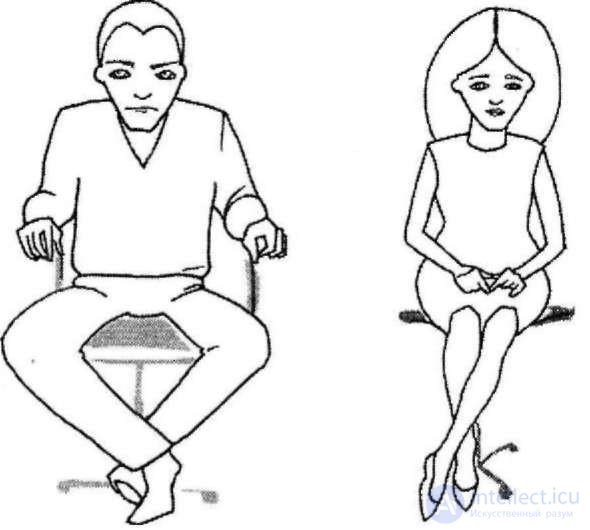When the ankles are crossed by men, they often clench their fists or tightly clasp the armrests of the chair, and also openly demonstrate the groin area (see figure). The female version of this posture is more restrained: the knees are connected, the feet are directed to the side, the hands are also directed to the side or one on the other lie on the knees.

Ankle crossing: the woman reduces the space occupied by the legs to a minimum, the man, on the contrary, tries to take as much space as possible. Based on more than thirty years of experience, we can say that the crossing of the ankles is in some sense similar to “lip biting.” This gesture shows that a person is holding back negative emotions, insecurity or fear. The feet are usually located under the chair, giving closure. When people participate in a conversation, their feet are relaxed.
Working with lawyers, we found that the defenders sitting near the courtroom before the meeting were three times more likely to cross their ankles than the plaintiffs. This is because they try to keep their emotional state under control. Observing the dentists' patients, we found that 88% of them had their ankles tightly crossed as soon as they were in the dental chair. Patients who came for a routine examination did so in 68% of cases. Those who were waiting for the anesthetic injection, crossed their ankles tightly in 98% of cases.
|
Many more people cross their ankles at a reception at a tax inspector than a dentist.
| |
Working with the police, customs officers and tax inspectors, we found that most people cross their ankles at the very beginning of the interview, however, this act is dictated more by fear than guilt.
We also analyzed those whose work is related to people. Most interviewers at one point or another cross their ankles under the chair, which means trying to cope with their emotions. Nirenberg and Calero found that when one of the negotiators crosses his ankles, this most often means that he is trying not to make serious concessions. When, after a series of questions, the person still uncoupled his legs, the opponents managed to persuade him to make concessions.
|
Ask positive questions about the mood and feelings of the person - and you will be able to force him to disengage his ankle-tied legs.
| |
Investigating the crossing of the ankles, we found that questions in 42% of cases helped people to relax and disengage their legs. This figure became even higher when the interviewer left the table and sat down next to the interviewee. In this case, the barrier disappeared, and people literally found themselves "on one side." Naturally, the conversation immediately became more open and personal.
Somehow we had the opportunity to advise a certain company on the issue of effective telephone communication. One of the managers has accumulated a huge number of accounts not paid by buyers. We watched him talk on the phone and found that his ankles were tightly linked under the chair during a conversation. Talking to us, he never did that. When we asked him if he liked his work, he replied: “Very! I have a wonderful job! ”Verbally, this person spoke quite unambiguously, but non-verbal signals suggested the opposite. “Are you sure?” We asked. The man paused for a bit, disengaged his ankles, opened his palms and admitted: “Honestly, she drives me crazy!” He told us that every day his customers call him several times, who are often rude and aggressive, and he has to restrain his feelings so that the deal does not fall through. We found that many sellers who do not like to communicate with customers on the phone, sit during a conversation, clasping the legs in the ankles.

Comments
To leave a comment
Body language
Terms: Body language